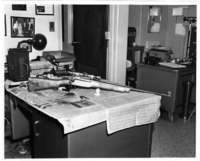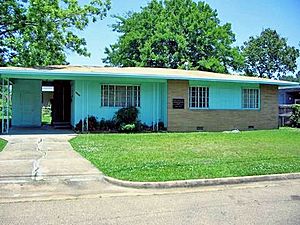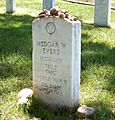Medgar Evers facts for kids
Quick facts for kids
Medgar Evers
|
|
|---|---|
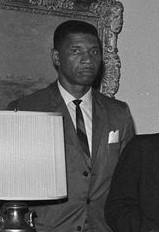
Evers at the White House in 1961
|
|
| Born |
Medgar Wiley Evers
July 2, 1925 Decatur, Mississippi, U.S.
|
| Died | June 12, 1963 (aged 37) Jackson, Mississippi, U.S.
|
| Cause of death | Gunshot wounds |
| Burial place | Arlington National Cemetery (with full military honors) |
| Education | Alcorn State University (BA) |
| Occupation | Civil rights activist |
| Spouse(s) | |
| Children | 4, Dylan J Robinson, Darrell K Evers, James V Evers, Reena D Evers |
| Relatives | Charles Evers (brother) |
| Military career | |
| Allegiance | United States |
| Service/ |
United States Army |
| Years of service | 1943–1945 |
| Rank | Sergeant |
| Battles/wars | |
Medgar Wiley Evers (July 2, 1925 – June 12, 1963) was an American civil rights leader. He worked to make sure all people, especially African Americans, had equal rights. He was the first field secretary in Mississippi for the NAACP.
Evers was a brave soldier in World War II. After the war, he worked to end segregation (the separation of people based on race). He fought for African Americans to have the right to vote and to use public places like parks and schools. He also wanted them to have more chances for good jobs and education.
In the 1950s, Evers became a key figure in the Civil Rights Movement. After the U.S. Supreme Court said that segregated schools were against the law in 1954 (in the Brown v. Board of Education case), Evers tried to get into the University of Mississippi's law school. He was not allowed in because he was Black. He continued to fight for equal rights for everyone. In 1963, he received the NAACP Spingarn Medal for his important work.
Contents
Early Life and Education
Medgar Evers was born on July 2, 1925, in Decatur, Mississippi. He was one of five children. His family owned a small farm. Medgar and his brothers and sisters had to walk 12 miles (19 km) every day to go to segregated schools. Even with this challenge, he finished high school.
Evers served in the United States Army during World War II from 1943 to 1945. He fought in Europe and was part of the Normandy landings in June 1944. After the war, he was honorably discharged as a sergeant.
In 1948, Evers went to Alcorn Agricultural and Mechanical College, which is now Alcorn State University. This was a historically Black college. He studied business and was active in many school activities, including debate and sports. He graduated in 1952. On December 24, 1951, he married his classmate, Myrlie Beasley. They had three children together.
Civil Rights Activism
After college, Medgar and Myrlie Evers moved to Mound Bayou, Mississippi. This town was started by African Americans. Medgar worked as a salesman and became involved in civil rights. He led the Regional Council of Negro Leadership (RCNL). He helped organize boycotts, like one against gas stations that would not let Black people use their restrooms.
In 1954, after the U.S. Supreme Court ruled against segregated schools, Evers applied to the University of Mississippi Law School. He was rejected because of his race. He did this as a test case for the NAACP.
On November 24, 1954, Evers became the NAACP's first field secretary in Mississippi. In this job, he helped start new NAACP groups and organized boycotts. He also helped James Meredith in his efforts to be the first African American student at the University of Mississippi in the early 1960s.
Evers also supported protests against segregation on public beaches in Biloxi, Mississippi. He worked to integrate buses and public parks in Jackson. He led efforts to help Black people register to vote. He also used boycotts to fight for integration in schools and at the Mississippi State Fair.
Because of his important work, Medgar Evers became a target for white supremacists. These were people who believed white people were better than others and resisted integration. In the weeks before he died, he faced many threats. His investigations into the 1955 lynching of Emmett Till and his support for Clyde Kennard made him a well-known Black leader. In May 1963, someone threw a firebomb at his home. In June 1963, he was almost hit by a car outside the NAACP office.
Assassination and Impact
Medgar Evers was killed on June 12, 1963, at his home in Jackson, Mississippi. He was shot by Byron De La Beckwith, a member of the White Citizens' Council. This group was formed to resist the integration of schools and civil rights efforts.
Evers was taken to a local hospital. At first, they would not let him in because he was Black. After his family explained who he was, he was admitted. He died about 50 minutes later at 37 years old. He was the first Black man to be admitted to an all-white hospital in Mississippi.
Many people across the country mourned Evers. He was buried on June 19 at Arlington National Cemetery with full military honors. More than 3,000 people attended his funeral.
Evers's death led to many civil rights protests. About 5,000 people marched in Jackson. Leaders like Martin Luther King Jr. were part of the procession. The person who killed Evers was not found guilty in his first two trials in the 1960s. However, he was finally convicted in 1994 after new evidence was found.
Medgar's wife, Myrlie Evers, became an important activist herself. She later became the national chair of the NAACP. In 1969, his brother Charles Evers became the first African American mayor of a Mississippi city since the time after the Civil War.
Medgar Evers's life and death have inspired many books, songs, and movies.
Legacy and Remembrance
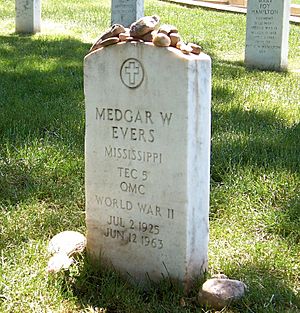
Medgar Evers has been remembered by many famous writers. In 1963, he was given the Spingarn Medal by the NAACP after his death. In 1969, Medgar Evers College was started in Brooklyn, New York, named in his honor.
His wife, Myrlie Evers, wrote a book about his life called For Us, the Living in 1967. In 1983, a TV movie was made based on the book. It showed Evers's life and work and won an award for best adapted drama.
In 1969, a community swimming pool in Seattle, Washington, was named after Evers. On June 28, 1992, the city of Jackson, Mississippi, put up a statue to honor him. A major road in Jackson, Delta Drive, was renamed in his honor. In December 2004, Jackson's airport was renamed Jackson–Medgar Wiley Evers International Airport.
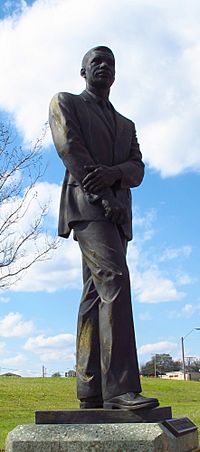
Myrlie Evers also started the Medgar Evers Institute in 1998 to keep his legacy alive. Later, its name was changed to the Medgar and Myrlie Evers Institute to honor both of them.
Medgar's brother, Charles Evers, continued his work in civil rights. He became the first African-American mayor elected in Mississippi in 1969. He passed away in 2020.
On the 40th anniversary of Evers's death, hundreds of people gathered at his grave in Arlington National Cemetery. They celebrated his life and what he achieved. Students who had researched Evers helped plan this event.
In 2009, a U.S. Navy ship, the USNS Medgar Evers (T-AKE-13), was named after him. His wife, Myrlie Evers-Williams, christened the ship in 2011.
In June 2013, a statue of Evers was put up at his old college, Alcorn State University. This was to mark 50 years since his death. Alumni and guests came from all over the world to honor his contributions.
On the 50th anniversary of his death, a tribute was held at Arlington National Cemetery. Former President Bill Clinton and other important leaders spoke about Evers's bravery and impact.
In 2017, the Medgar and Myrlie Evers House was recognized as a special historic place. In 2019, it became a National Monument.
Images for kids
See also
 In Spanish: Medgar Evers para niños
In Spanish: Medgar Evers para niños


